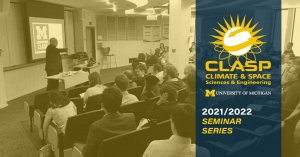Presented By: Climate and Space Sciences and Engineering
CLASP Seminar Series: Abby Hutson of NOAA/CIGLR

Abby Hutson of NOAA/CIGLR will give a lecture as part of the CLASP Seminar Series. Please join us!
Ms. Hutson's presentation is titled "Using a Statistical Ensemble Technique to Determine Why Some Supercells Produce Tornadoes, and Why Others Do Not" and will take place on Thursday, September 23 at 3:30 p.m. EDT.
This seminar will be in person at the Climate and Space Research Building Auditorium, Room 2246.
The seminar may also be viewed via Zoom.
Please contact lhopkins@umich to request zoom access.
ABSTRACT:
Meteorologists have made tremendous progress understanding and forecasting atmospheric conditions suitable for tornado formation. While we have shown great skill in predicting supercell thunderstorms - storms with a single, rotating updraft that produce 75% of all reported tornadoes - it is clear that we still lack the ability to accurately predict which of those supercells will produce tornadoes. Recent research has shown that although environmental atmospheric conditions are important for tornado formation, storm-induced features - such as kinematic and thermodynamic perturbations induced by downdrafts - are key in tornado initiation and maintenance.
In this study, an ensemble of 51 different high-resolution idealized simulated supercells is analyzed to determine what features tornadic supercells have in common - and what features nontornadic supercells lack. The supercells are created by inducing random perturbations to a uniform environment using Cloud Model Version 1 (CM1). A statistical analysis called Ensemble Sensitivity Analysis (ESA) is employed and uncovers time-sensitive dynamical relationships between storm-scale features and enhanced vertical vorticity near the surface. In particular, a feature in the forward flank of the storm called the Streamwise Vorticity Current (SVC) will be shown to have a unique link to vertical vorticity initiation and maintenance.
The last third of this presentation will switch gears from small time- and spatial-scales to the larger climate scale. In the Great Lakes Region, our weather and climate conditions are greatly impacted by the Lakes. It is important to understand how our climate will change in the future, but the global climate ensemble used to predict our changing climate lacks the spatial resolution to adequately model the Great Lakes’ interaction with our atmosphere. Current research with GLERL and CIGLR involves optimizing a WRF-based Regional Climate Model (RCM) for the Great Lakes Region that dynamically downscales global climate model (GCM) information so that it is accurately simulated on a much smaller scale. Different methods that will be tested include finding the best cumulus parameterization scheme to represent precipitation amounts and determining the optimal method for nudging the internal simulation toward the driving GCM information.
Ms. Hutson's presentation is titled "Using a Statistical Ensemble Technique to Determine Why Some Supercells Produce Tornadoes, and Why Others Do Not" and will take place on Thursday, September 23 at 3:30 p.m. EDT.
This seminar will be in person at the Climate and Space Research Building Auditorium, Room 2246.
The seminar may also be viewed via Zoom.
Please contact lhopkins@umich to request zoom access.
ABSTRACT:
Meteorologists have made tremendous progress understanding and forecasting atmospheric conditions suitable for tornado formation. While we have shown great skill in predicting supercell thunderstorms - storms with a single, rotating updraft that produce 75% of all reported tornadoes - it is clear that we still lack the ability to accurately predict which of those supercells will produce tornadoes. Recent research has shown that although environmental atmospheric conditions are important for tornado formation, storm-induced features - such as kinematic and thermodynamic perturbations induced by downdrafts - are key in tornado initiation and maintenance.
In this study, an ensemble of 51 different high-resolution idealized simulated supercells is analyzed to determine what features tornadic supercells have in common - and what features nontornadic supercells lack. The supercells are created by inducing random perturbations to a uniform environment using Cloud Model Version 1 (CM1). A statistical analysis called Ensemble Sensitivity Analysis (ESA) is employed and uncovers time-sensitive dynamical relationships between storm-scale features and enhanced vertical vorticity near the surface. In particular, a feature in the forward flank of the storm called the Streamwise Vorticity Current (SVC) will be shown to have a unique link to vertical vorticity initiation and maintenance.
The last third of this presentation will switch gears from small time- and spatial-scales to the larger climate scale. In the Great Lakes Region, our weather and climate conditions are greatly impacted by the Lakes. It is important to understand how our climate will change in the future, but the global climate ensemble used to predict our changing climate lacks the spatial resolution to adequately model the Great Lakes’ interaction with our atmosphere. Current research with GLERL and CIGLR involves optimizing a WRF-based Regional Climate Model (RCM) for the Great Lakes Region that dynamically downscales global climate model (GCM) information so that it is accurately simulated on a much smaller scale. Different methods that will be tested include finding the best cumulus parameterization scheme to represent precipitation amounts and determining the optimal method for nudging the internal simulation toward the driving GCM information.
Explore Similar Events
-
Loading Similar Events...
